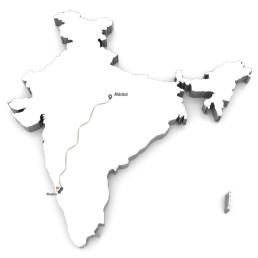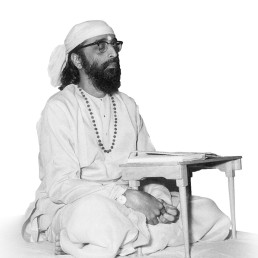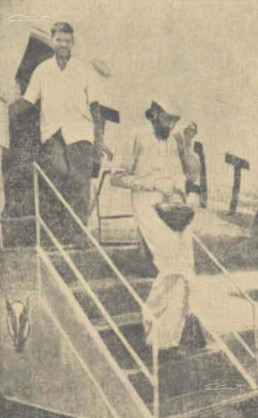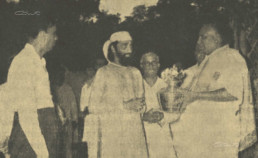
Jnana Yajna 47

Year & Dates:
October 20, 1958 to November 09, 1958

Yajna Topic:
Kenopanishad

Place:
Mangaluru (Mangalore), India.
The 47th Jnana Yajna, the first of Pujya Gurudev’s Jnana Yajnas in the coastal city of Mangaluru and the 12th in the year 1958, was also the only Upanishad Jnana Yajna in 1958. When Pujya Gurudev landed on the morning of October 20, 1958, those who received Him were thrilled. More invigorating was when He visited the yajnashala in the Government College playground even before He went to the guesthouse to rest. The organizers were amazed at the way He thoroughly inspected all arrangements for an efficient yajna – the 60’ x 120’ pandal, its bright, fluorescent lighting for aspirants to read the smallest print, the floor with sand for comfortable sitting, chairs only for the physically challenged, adequate loudspeakers, and the auspicious dias with the shining Om symbol and the portraits of Adi Shankaracharya and Parama Guru Swami Tapovanam – His powers of observation, organization, and execution were worth deep study in themselves.
A Jnani and Inimitable Leader
From the moment that Pujya Gurudev began His discourse with His resonating utterance of Om, the audience was mesmerized. Through the mornings with Atma Bodha and the evenings with Kenopanishad, the numbers of the attendees swelled so much that the pandal was extended. It was as though the whole place was in a spiritual trance – even the leaves of trees didn’t rustle as the air was calm; nobody in the thousands even sneezed, and until Pujya Gurudev concluded with “Tomorrow then…,” time seemed suspended.
The three-day Mrityunjya Havana conducted in perfect Vedic style reassured the orthodox that the modern Swami wasn’t one to decry rituals. The 3-day Akhanda Kirtan also gave everyone an opportunity to revel in devotion. On November 8th, when Pujya Gurudev concluded His pravachans, the adoring audience didn’t want to leave.
The final segment of the Jnana Yajna was an unforgettable ‘one-day’ sannyasa yatra to the most hallowed spot of Talakaveri, the source of the holy Kaveri river. Pujya Gurudev was like the Pied Piper and a stately Commander as He outlined the yatra plan and guidelines to the huge group in those 13 buses and 20 cars. The 106-mile drive in the panoramic Western Ghats with Bhajans and kirtans echoing through the countryside and mountains was heavenly, especially since Pujya Gurudev spent time in each bus. The way He cared for the pilgrims indicates the magnanimous love that He personified. He was the last one to board a bus, have tea or dinner, and He slept after everyone had gone to sleep. When He led everyone to the sacred birthplace of the Kaveri river to immerse the ashes of the Mrtyunjaya Havana and complete the Avabhrta snaana in the sacred temple tank, it was a transformational experience. Pujya Gurudev’s ability to guide and enlighten is legendary.
Photo Gallery

“Think,” Says Pujya Gurudev
Stop the mind. Then there is no world, Samsara. “Wake yourself up; that is all. And this we CAN do. That waking up can come only when we have come to the feet of our Guru, with a pure heart and a bright intellect enquiring to him, “where is the inner Self”. In delving into this Truth a Guide is absolutely essential for all but the exceptional few. From the outside we have to take a right-about-turn of our gaze and turn it inwards.
From Kenopanishad Yajna Prasad
In order to gain a godly fact or profit you have to live every moment vitally aware of what is happening not only outside ourselves but also in our own within. But unfortunately the instruments, our mind and intellect, are left to run into ruin. Just as the great-grand-father’s razor, they are left in the Wall-shelf rusting!! For generations past we have been allowing the mind and the intellect, our great instruments of knowing, understanding, feeling and thinking, to lie away in neglect. Let us repair and make use of them. It is accomplished by sincere and long Sadhana.
From Kenopanishad Yajna Prasad
What are Upanishads?
Gain insights into the dynamic interactions between students and teachers in the Upanishads, where diverse questions lead to tailored discussions. Discover how different approaches ultimately converge towards the highest state of consciousness.




